
The Atari 2600 is a home video game console developed and produced by Atari, Inc. Released in September 1977 as the Atari Video Computer System, it popularized microprocessor-based hardware and games stored on swappable ROM cartridges, a format first used with the Fairchild Channel F in 1976. The VCS was bundled with two joystick controllers, a conjoined pair of paddle controllers, and a game cartridge—initially Combat and later Pac-Man. Sears sold the system as the Tele-Games Video Arcade. Atari rebranded the VCS as the Atari 2600 in November 1982 alongside the release of the Atari 5200.

Millipede is a fixed shooter video game released in arcades by Atari, Inc. in 1982. The sequel to 1981's Centipede, it has more gameplay variety and a wider array of insects than the original. The objective is to score as many points as possible by destroying all segments of the millipede as it moves toward the bottom of the screen, as well as eliminating or avoiding other enemies. The game is played with a trackball and a single fire button which can be held down for rapid-fire.

Centipede is a 1981 fixed shooter arcade video game developed and published by Atari, Inc. Designed by Dona Bailey and Ed Logg, it was one of the most commercially successful games from the golden age of arcade video games and one of the first with a significant female player base. The primary objective is to shoot all the segments of a centipede that winds down the playing field. An arcade sequel, Millipede, followed in 1982.

Frogger is a 1981 arcade action game developed by Konami and manufactured by Sega. In North America, it was released by Sega/Gremlin. The object of the game is to direct five frogs to their homes by dodging traffic on a busy road, then crossing a river by jumping on floating logs and alligators.

Berzerk is a multidirectional shooter designed by Alan McNeil and released for arcades in 1980 by Stern Electronics of Chicago. Following Taito's Stratovox, it is one of the first arcade video games with speech synthesis. Berzerk places the player in a series of top-down, maze-like rooms containing armed robots. Home ports were published for the Atari 2600, Atari 5200, and Vectrex.

Mouse Trap is a maze video game developed by Exidy and released in arcades in 1981. It is similar to Pac-Man, with the main character replaced by a mouse, the dots with cheese, the ghosts with cats, and the energizers with bones. After collecting a bone, pressing a button turns the mouse into a dog for a brief period of time. Color-coded doors in the maze can be toggled by pressing a button of the same color. A hawk periodically flies across the maze, unrestricted by walls.
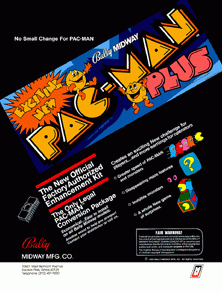
Pac-Man Plus is an arcade game that was released by Bally Midway in 1983. It is part of the Pac-Man series of games.

Jr. Pac-Man is an arcade video game developed by General Computer Corporation and released by Bally Midway on August 13, 1983. It has the same gameplay as prior entries in the series, but the maze in Jr. Pac-Man scrolls horizontally and has no escape tunnels. The bonus item which moves around the maze changes dots into a form which slows Jr. Pac-Man as they are being eaten.

Food Fight is an arcade video game developed by General Computer Corporation and released by Atari, Inc. in March 1983. The player guides Charley Chuck, who is trying to eat an ice cream cone before it melts, while avoiding four chefs bent on stopping him. 1,951 arcade cabinets were sold.

H.E.R.O. is a video game designed by John Van Ryzin and published by Activision for the Atari 2600 in March 1984. It was ported to the Apple II, Atari 5200, Atari 8-bit family, ColecoVision, Commodore 64, MSX, and ZX Spectrum.
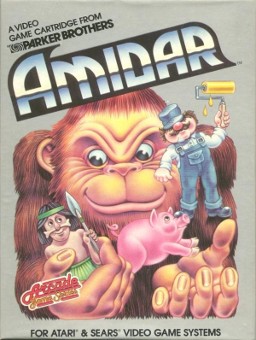
Amidar is a video game developed by Konami and released in arcades in 1981 by Stern. The format is similar to that of Pac-Man: the player moves around a fixed rectilinear lattice, attempting to visit each location on the board while avoiding the enemies. When each spot has been visited, the player moves to the next level. The game and its name have their roots in the Japanese lot drawing game Amidakuji. The bonus level in Amidar is a nearly exact replication of an Amidakuji game and the way the enemies move conform to the Amidakuji rules; this is referred to in the attract mode as "Amidar movement."

Haunted House is a 1982 adventure video game programmed by James Andreasen for the Atari Video Computer System and published by Atari. The player controls an avatar shaped like a pair of eyes who explores a mansion seeking out parts of an urn to return to the entrance. The game world is populated by roaming enemies including vampire bats, tarantulas, and a ghost. Haunted House was among the first games to use player-controlled scrolling between large portions of the visual space.
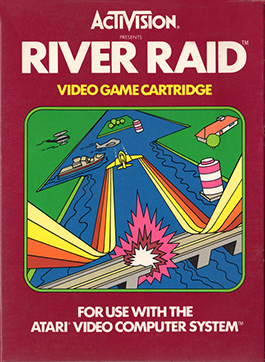
River Raid is a video game developed by Carol Shaw for the Atari Video Computer System and released in 1982 by Activision. The player controls a fighter jet over the River of No Return in a raid behind enemy lines. The goal is to navigate the flight by destroying enemies while collecting fuel and not crashing.

The Atari Flashback series are a line of dedicated video game consoles designed, produced, published and marketed by AtGames under license from Atari SA. The Flashback consoles are "plug-and-play" versions of the Atari 2600 console. They contain built-in games rather than using the ROM cartridges utilized by the 2600. Most of the games are classics that were previously released for the 2600, although some Flashback consoles include previously unreleased prototype games as well.
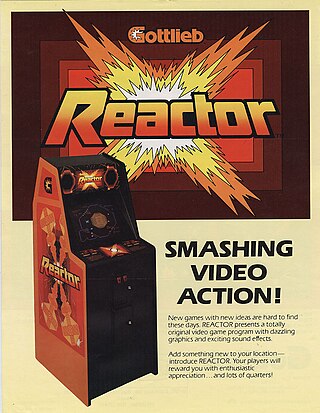
Reactor is an arcade video game released in 1982 by Gottlieb. The object of the game is to cool down the core of a nuclear reactor without being pushed into its walls by swarms of subatomic particles. Reactor was developed by Tim Skelly, who previously designed and programmed a series of vector graphics arcade games for Cinematronics, including Rip Off. It was the first arcade game to credit the developer on the title screen. Reactor was ported to the Atari 2600 by Charlie Heath and published by Parker Brothers the same year as the original.

Pac-Man is a 1982 maze video game developed and published by Atari, Inc. under official license by Namco, and an adaptation of the 1980 hit arcade game of the same name. The player controls the title character, who attempts to consume all of the wafers in a maze while avoiding four ghosts that pursue him. Eating flashing wafers at the corners of the screen causes the ghosts to temporarily turn blue and flee, allowing Pac-Man to eat them for bonus points. Once eaten, a ghost is reduced to a pair of eyes, which return to the center of the maze to be restored.

The Atari 2600 hardware was based on the MOS Technology 6507 chip, offering a maximum resolution of 160 x 192 pixels (NTSC), 128 colors, 128 bytes of RAM with 4 KB on cartridges. The design experienced many makeovers and revisions during its 14-year production history, from the original "heavy sixer" to the Atari 2600 Jr. at the end. The system also has many controllers and third-party peripherals.
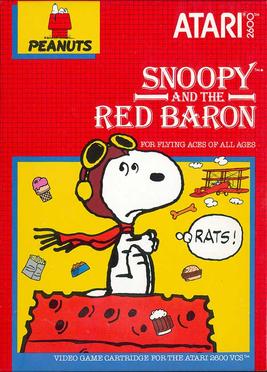
Snoopy and the Red Baron is an Atari 2600 shoot 'em up featuring Peanuts character Snoopy and his aviation rival, the Red Baron. It is the first video game based on Peanuts by Charles M. Schulz and was published by Atari, Inc. in 1983.

The Atari CX40 joystick was the first widely used cross-platform game controller. The original CX10 was released with the Atari Video Computer System in 1977 and became the primary input device for most games on the platform. The CX10 was replaced after a year by the simpler and less expensive CX40. The addition of the Atari joystick port to other platforms cemented its popularity. It was the standard for the Atari 8-bit family of home computers and was compatible with the VIC-20, Commodore 64, Commodore 128, MSX, and later the Atari ST and Amiga. Third-party adapters allowed it to be used on other systems, such as the Apple II, TI-99/4A, and the ZX Spectrum.
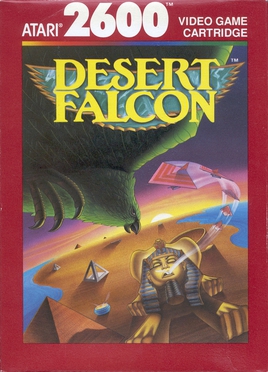
Desert Falcon is a scrolling shooter developed by General Computer Corporation for the Atari 7800 and Atari 2600 and published by Atari Corporation in 1987. It was initially announced in 1984, prior to being named Desert Falcon, as one of the planned launch titles for the 7800. A cartridge version for the Atari 8-bit family, with XEGS-styled packaging, followed in 1988.





















